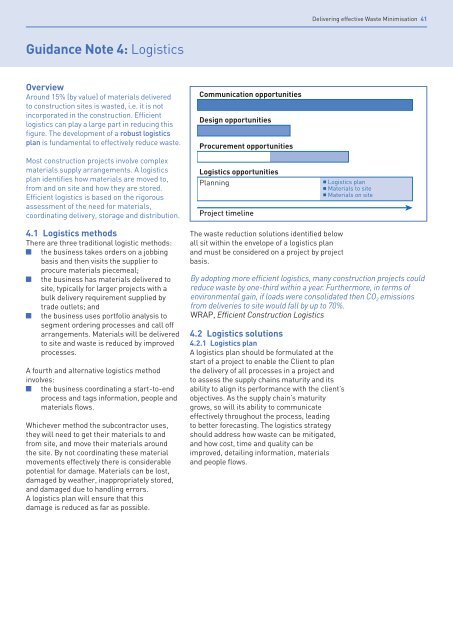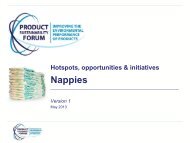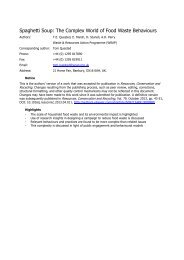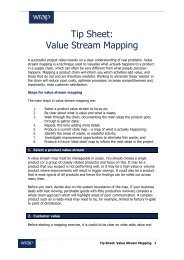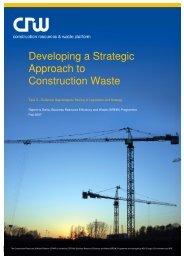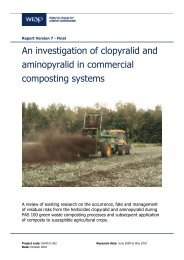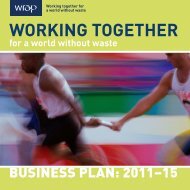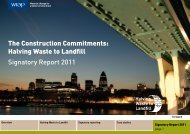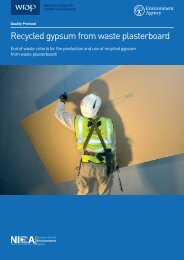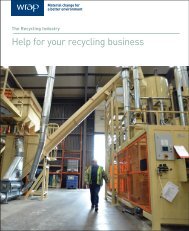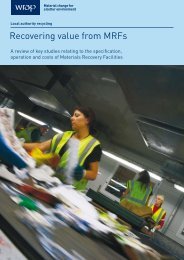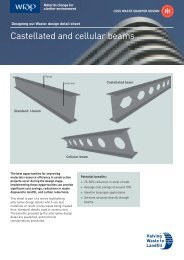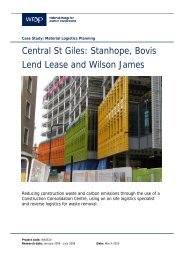Delivering effective Waste Minimisation - Wrap
Delivering effective Waste Minimisation - Wrap
Delivering effective Waste Minimisation - Wrap
You also want an ePaper? Increase the reach of your titles
YUMPU automatically turns print PDFs into web optimized ePapers that Google loves.
<strong>Delivering</strong> <strong>effective</strong> <strong>Waste</strong> <strong>Minimisation</strong> 41<br />
Guidance Note 4: Logistics<br />
Overview<br />
Around 15% (by value) of materials delivered<br />
to construction sites is wasted, i.e. it is not<br />
incorporated in the construction. Efficient<br />
logistics can play a large part in reducing this<br />
figure. The development of a robust logistics<br />
plan is fundamental to <strong>effective</strong>ly reduce waste.<br />
Most construction projects involve complex<br />
materials supply arrangements. A logistics<br />
plan identifies how materials are moved to,<br />
from and on site and how they are stored.<br />
Efficient logistics is based on the rigorous<br />
assessment of the need for materials,<br />
coordinating delivery, storage and distribution.<br />
Communication opportunities<br />
Design opportunities<br />
Procurement opportunities<br />
Logistics opportunities<br />
Planning<br />
Project timeline<br />
• Logistics plan<br />
• Materials to site<br />
• Materials on site<br />
4.1 Logistics methods<br />
There are three traditional logistic methods:<br />
the business takes orders on a jobbing<br />
basis and then visits the supplier to<br />
procure materials piecemeal;<br />
the business has materials delivered to<br />
site, typically for larger projects with a<br />
bulk delivery requirement supplied by<br />
trade outlets; and<br />
the business uses portfolio analysis to<br />
segment ordering processes and call off<br />
arrangements. Materials will be delivered<br />
to site and waste is reduced by improved<br />
processes.<br />
A fourth and alternative logistics method<br />
involves:<br />
the business coordinating a start-to-end<br />
process and tags information, people and<br />
materials flows.<br />
Whichever method the subcontractor uses,<br />
they will need to get their materials to and<br />
from site, and move their materials around<br />
the site. By not coordinating these material<br />
movements <strong>effective</strong>ly there is considerable<br />
potential for damage. Materials can be lost,<br />
damaged by weather, inappropriately stored,<br />
and damaged due to handling errors.<br />
A logistics plan will ensure that this<br />
damage is reduced as far as possible.<br />
The waste reduction solutions identified below<br />
all sit within the envelope of a logistics plan<br />
and must be considered on a project by project<br />
basis.<br />
By adopting more efficient logistics, many construction projects could<br />
reduce waste by one-third within a year. Furthermore, in terms of<br />
environmental gain, if loads were consolidated then CO 2 emissions<br />
from deliveries to site would fall by up to 70%.<br />
WRAP, Efficient Construction Logistics<br />
4.2 Logistics solutions<br />
4.2.1 Logistics plan<br />
A logistics plan should be formulated at the<br />
start of a project to enable the Client to plan<br />
the delivery of all processes in a project and<br />
to assess the supply chains maturity and its<br />
ability to align its performance with the client’s<br />
objectives. As the supply chain’s maturity<br />
grows, so will its ability to communicate<br />
<strong>effective</strong>ly throughout the process, leading<br />
to better forecasting. The logistics strategy<br />
should address how waste can be mitigated,<br />
and how cost, time and quality can be<br />
improved, detailing information, materials<br />
and people flows.


